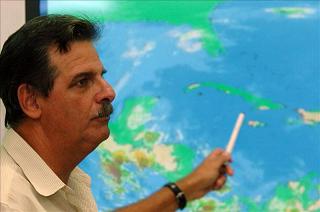
U.S. and Cuba, valuable meteorological partners
By Jeanne Friedman-Rudovsky
HAVANA — Old computer processors whirred and paint crumbled from the walls in the National Prognostic Center of Cuba’s Meteorological Institute, set on a rise above Havana’s old city. Half a dozen meteorologists shifted their gaze between satellite images on large video screens and a giant overhead map of the United States.
They monitor the region’s weather every day, but their gaze grows especially intense in hurricane season. As the center’s director, José Rubiera, explained, almost every hurricane that strikes the Southern United States passes through Cuba first. “A hurricane that hits Cuba doesn’t ask for a visa before entering the United States,” he said.

This shared destiny has led to a rare truce between the two nations, which have had no bilateral relations for more than 50 years. Their meteorological agencies exchange satellite data, jointly analyze radar and collaborate on storm forecasting.
When a storm is approaching, “we call the National Prognostic Center or they call us, whoever gets to the phone first,” said Lixion Avila, a senior specialist at the United States government’s National Hurricane Center.
Dr. Avila called Cuba one of the United States’ most valuable meteorological partners. “Cuba has a long history of excellent forecasting with a tremendous record of data,” he said.
Or as Michael T. Clegg, foreign secretary of the National Academy of Sciences, put it, “It seems that the substantial threat to the human population” posed by storms “is taken seriously enough to make cooperation more desirable.”
And some experts on both sides wish that cooperation would extend to the nonmeteorological aspects of storms. The countries’ disaster management agencies have no direct communication.
“Cuba manages hurricanes well,” said Russel L. Honoré, the retired lieutenant general who commanded military relief efforts after Hurricane Katrina devastated New Orleans in 2005. He has since become a specialist on disaster preparedness and has traveled to Cuba three times in recent years. “We could be learning from them,” he added.
Cuba consistently weathers Category 4 and 5 hurricanes with relatively few casualties. The Center for International Policy, a research and advocacy group based in Washington, says a person is 15 times as likely to be killed by a hurricane in the United States as in Cuba. The island did suffer a body blow last fall from Hurricane Sandy, the second-biggest storm in Cuban history. Before it struck the United States’ Eastern Seaboard, Sandy slammed into Santiago de Cuba, the island’s second-largest city. Eleven people died, and President Raúl Castro said that Santiago looked “like a bombed city.”
Half of its buildings were damaged; almost 16,000 in the city and the surrounding province were destroyed. There were small outbreaks of cholera and dengue fever. Some residents interviewed for this article said they went almost a month without electricity.
“Cuba has an enormous amount of deteriorated buildings that can’t withstand natural disasters,” said Ricardo Mena, a United Nations official responsible for disaster risk reduction in the Americas. He added that while a hospital, for example, might need rebuilding, “that’s very costly and they don’t have the resources to do it.”
Still, he and other analysts emphasized that Cuba would have suffered a great deal more if not for its well-rehearsed storm preparation system.
It is a multilevel process that starts with the young. Grade school students practice evacuations; high-school students monitor neighborhoods to identify weak trees and other hazards.
Dr. Rubiera is the nation’s sole hurricane forecaster, much praised by Cubans for his calm, authoritative manner. “We trust Rubiera because he knows what he’s talking about,” said Camilo Guara, a Havana resident.
In the event of a storm, the head of every institution — schools, hospitals, hotels — is considered a member of the Cuban Civil Defense force, responsible for the well-being of people around them. Tight state control means Cuba can mandate evacuations, mobilize quickly and put Dr. Rubiera’s face on every TV screen. “Cuba is not a model that could be fully replicated anywhere else,” Mr. Mena said.
In Pinar del Río, the province most vulnerable, the government deploys large brigades to prepare for disaster.
“If you have nowhere to go, then there’s the state shelters with food and water and doctors,” said María Fajardo, a resident.
Still, evacuees are more likely to take shelter with family members, friends or strangers, according to the relief organization Oxfam. “We have learned to take care of ourselves and not just rely on the state,” said Yesi Mejía, 43, of Havana.
In that way, they are no different from storm survivors in the United States. Barbara Morita, a first responder from California who visited Cuba to learn more about its disaster preparations, said that after Hurricane Katrina, “so many people told me, ‘I wouldn’t be alive if my neighbor hadn’t come over.’ ” And she added, “Maybe more could have been saved if we were better prepared.”
(From The New York Times)


